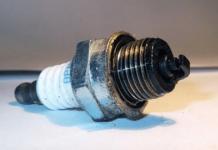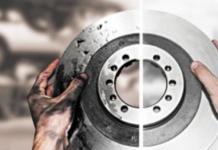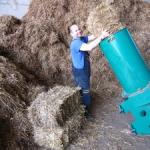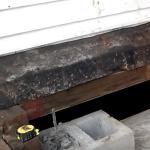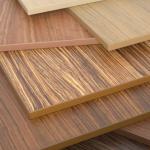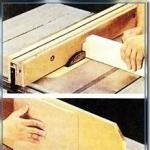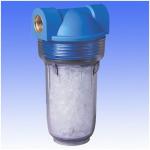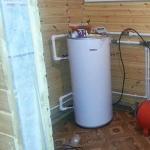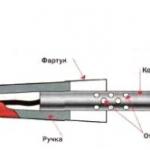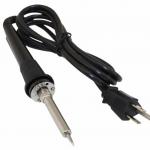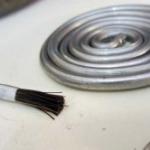Blueing or oxidation is a method of surface coating (finishing) of metal products in blue, black, blue-black or tint colors by exposing them to a chemical and thermal method.
It is used for the purpose of corrosion protection of metal products, and also gives the surface an attractive tint. There are many ways to surface tint metals. The main one is the creation of an oxide film.
The most common are chemical (alkaline and acid) and thermal effects on the surface. As a result of such treatment, the chemical composition and structure of the surface layer change. Externally, this is manifested by the formation of a film in the form of metal oxide.
You can independently perform the coating using simpler technologies.
Common home methods for protecting and decorating metal surfaces include:
- boiling parts in special chemical compositions that you can cook yourself;
- oil coating followed by heat treatment;
- application to the surface of the finished product with a brush.
Carrying out work during chemical bluing is associated with chemical etching and cleaning operations, as well as with mechanical grinding and wiping the surface.
In order to use bluing at home with the help of chemical reagents, you need to create certain conditions:
- provide the working room with ventilation or exhaust;
- prepare a container from a neutral material that does not collapse under the action of chemicals. A vessel made of heat-resistant glass, faience or porcelain is best suited. If prolonged boiling of the solution is required, then a stainless steel container can be used;
- the container must have sufficient volume so that the part is completely covered with the composition;
- stock up on protective equipment: gloves, a protective mask or goggles, aprons.
Features of chemical bluing and recipes for some compositions
Before performing work, the surface of the metal product is subjected to processing: removal of the old oxide layer by sanding and degreasing with a solvent.

A permanent blued coating is mainly formed in a boiling solution throughout the entire dyeing cycle. To obtain a strong film, the process should last from 30 minutes to an hour and a half, so the boiling solution is periodically topped up to ensure complete coverage of the part.
After the end of the process, the part is thoroughly washed using detergents, and then lubricated with oil.
For homework, the alkaline oxidation method is mainly used. Consider some options for the chemical oxidation of metals in an alkaline medium.
Method number 1:
- Water is poured into a container (porcelain) of the appropriate size and sodium nitrate (sodium nitrate) and caustic soda (sodium hydroxide) are dissolved in it in the ratio: 30 g of sodium and 100 g of soda per 100 ml.
- The mixture is heated to 140 - 160 ° C, and the workpiece is placed in it, which is there for at least 30 minutes.
With the right process, a deep black coating will be obtained, sometimes with a bluish tint.
Method number 2:
The bluish tint of the film can be obtained by using a boiling saturated alkaline solution in which potassium or sodium hydroxide is dissolved in high concentration. At least 700 grams of the chemical is dissolved in 1 liter of water.
These recipes are provided as an example. There are many other chemical formulations using nitrites and nitrates.

Oxidation in an acid medium is carried out at lower temperatures. For example, when using an acid solution consisting of:
- calcium nitrate - 30 hours,
- orthophosphoric acid - 1 hour,
- manganese dioxide - 1 tsp.
Oxidation is carried out by keeping the workpiece in the solution for at least 30-45 minutes at 100°C.
Metal burnishing agents
Simple coating methods that can be used at home include technologies for surface application of oil, saltpeter and the finished Clover product.
These bluing tools are available to use and allow you to work at home without much preparation.
Consider ways to create a film using each of them.
Oil coating
The technology of creating a protective film using oil is the most common for home use.

It is carried out like this:
- the skinned and fat-free product is covered with machine or sunflower oil;
- then it is placed in the oven and heated to 350 - 400 ° C;
- after cooling, the surface of the part becomes brown or black;
- oil residues from the part must be removed with a rag;
- to obtain a more saturated color, the process should be repeated several times.
You can use different oils, such as gun oil, linseed or olive oil. It can be applied with a brush or by dipping the part in an oil composition.
If blackening is required on any part of the part, then it is better to use firing with a blowtorch. In the process of such firing, the color change in the surface of the workpiece is clearly visible. Upon reaching a saturated brown-black color, heat treatment can be stopped.
The use of saltpeter
A good result of chemical bluing gives a classic solution using saltpeter in addition to those given earlier. As a result of boiling the part in a solution of sodium nitrate at a temperature of 130 - 150 ° C, a durable oxide coating of a brilliant black-blue hue is obtained.
Saltpeter composition recipe:
- Distilled water - 1 liter;
- Sodium nitrate (NaNO3) - 500 g;
- Caustic caustic (NaOH) - 500 g.
On sale there are ready-made kits with nitrate for oxidation.
You can watch the process of bluing in saltpeter in the video:
The surface with this treatment looks smooth and does not require additional polishing.
Surface treatment with "Clover"
You can carry out the processing of a metal surface with a ready-made tool "Clover". It has a gel-like consistency and is sold in small containers of 50 ml.

It is used for minor corrosion damage to the metal. To get the maximum coloring of the product, you need to process "Clover" two to three times. Before applying it, the part must be sanded and degreased.
The product is applied with a brush and kept for 2 minutes. If a whitish-yellow coating appears, it should be washed off with warm water, and the surface should be wiped dry with a cloth.
The advantage of this tool is ease of use, so it is often used to cover weapons. On steels containing more than 3% Cr, it has no effect.
Cold bluing at home
The use of the "Clover" tool does not require additional heating of the workpiece, therefore, the method of such processing is referred to as cold. In addition to it, for cold bluing at home, other means are used, which are also applied to the treated surface with a brush.
For example, they use the domestic drug Voron-3M.

When applied to a metal surface, a dense black film is formed. Therefore, such a coating is called blackening of the metal.
Also popular is the imported Parisian oxide, which contains selenium.

The drug includes three vials. One composition is intended for pre-treatment of the surface, the second is the active composition, and the third provides protection for the formed coating.
The solution is also applied to the product with a brush, after obtaining the color, the residues are washed off the surface with warm water.
Cold working is used for small parts. Especially with this method, it is good to carry out bluing of the gun, since the method of hot boiling in chemical solutions cannot be applied to it.
Burning steel at home
The question of how to make blued steel at home is of interest to many.
Most of the parts that are burnished are steel products. Therefore, the methods of metal surface treatment by oxidation and oil film coating described above are mainly applied to steel alloys.
Many grades of steel are prone to rust formation. The coating for steel products primarily serves as protection against corrosion and at the same time gives them an attractive appearance. The degree of protection and the color of the oxide film depends on the thickness of the layer and the reagents used. The thickness can vary from 1 to 10 microns.

When bluing steel products by a chemical method, the choice of solution components when using heating to high temperatures should be approached with caution. For example, there is a ban on such processing of hardened parts, as well as steels that cannot be heated to high temperatures. This can lead to deterioration of their technological properties.
It is for this reason that, if high heat treatment is necessary, it is recommended to use alkaline solutions. They are more forgiving.
Oxidation in acid compositions is carried out at lower temperatures. For example, when using an acid composition consisting of:
- calcium nitrate - 30 hours,
- orthophosphoric acid - 1 hour,
- manganese dioxide - 1 hour,
- oxidation is carried out at a temperature of 100 ° C, keeping the part in the solution for at least 30-45 minutes.
Metal blackening
When steel billets are heated in an acidic or alkaline environment, a film of different shades may form on the surface. Blueing includes all the colors characteristic of tarnish. They change as the film thickness increases from yellow, brown, purple, then to gray, blue and black.
Technical process "Ultra-Black 407"
BLACK STAINLESS STEEL
Process used for chemical alkaline oxidation of stainless steels with black coloration
Oxidation is carried out in a hot alkaline solution of the salt composition " Ultra Black 407", which representsan invented powdery mixture of salts and caustic soda - the company does not need to purchase any additional chemicals
In the same bath can oxidize not only stainless steel, but also malleable steels, cast irons and mild steels with the formation of black coatings on them
processing stages. Parts to be blackened can be processed in baskets, tumbling drums, or on mild steel hooks or hangers.
1. CLEANING AND DEGREASING: Parts must be thoroughly cleaned and degreased. For chemical degreasing, it is recommended to use branded technical detergents "E-Clean 173" (this TMS is also suitable for electric degreasing), "E-Clean 163" (degreases at low temperatures) and others. Any other chemical degreasing solutions capable of providing adequate surface preparation prior to oxidation may also be used.
2. RINSING: in a cascade type bath with bottom water supply.
3. ACTIVATION: all stainless steels, due to the presence of chromium oxide on their surface, are in a passive state, therefore, before blackening, this oxide must be removed by activation in a solution of the proprietary preparation "E-Peak 211" 120-240 g / l, 2–5 min, temperature from workshop to 65–85°C (selected).
If the passive state is characterized by high stability, then activation may require additional treatment in hydrochloric acid solution (180–200 g/l), 5 min, shop temperature; followed by rinsing in cold water, and then treatment in a dilute solution of the branded preparation "E-Peak 211" (7.5-15 g / l), 30 s - 3 min, 65–85 °С and more.
4. RINSING: in a cascade type bath with bottom water supply.
5. BLACKING (OXIDATION): immerse the parts in a boiling solution of "Ultra-Black 407" ( temperature 124 ± 3 °C) until their surface turns a rich black color. Required dive time may vary from 2 to 15 min depending on the weight of the parts and the type and condition of the stainless steel. Excessive immersion time can lead to poor adhesion of the forming layer. However, most blackening problems can be the result of improper surface preparation or a deviation in the boiling point of the oxidation solution from the recommended values.
The presence of scale, oxides, welds and other defects on the surface of stainless steel products impairs their performance properties, spoils the appearance of objects. In the presence of such defects, additional processing is required. The most popular type of processing is stainless steel etching at home.
Stainless steel processing methods
For the processing of stainless steel, a number of methods have been developed to give products the required parameters and aesthetic appearance. At home, you can use the following methods:
- etching of stainless steel;
- painting;
- satin finish (grinding and polishing);
- bluing;
- chrome plating.






Stainless steel pickling procedure
The main way to clean the surface of stainless steel is pickling (chemical and electrochemical). This method is used after heat treatment of the product, cold and hot plastic deformation, as well as to remove traces of welding. In addition to cleaning the surface, pickling stainless steel restores the passive layer that protects the stainless alloy from the damaging effects of high temperatures.

The method is based on the chemical interaction of the metal surface with acids of various concentrations, mainly sulfuric or hydrochloric, molten alkaline compositions. The use of acids involves a two-stage process: first treatment with a sulfuric acid solution, then placement in a nitric acid environment. When using the alkaline method, a caustic soda solution is used.
When processing stainless steel, careful control over compliance with technological conditions is necessary. The aggressive environment in which the metal is placed should only affect its surface, destroying defects without changing the structure of the object itself. Special additives are used to prevent over-etching.
Electrochemical (galvanic) etching
To do this, you need to follow a number of procedures.
Solution preparation. Prepare an aqueous acid solution chosen for etching. It is necessary to carefully calculate its percentage.

Surface preparation. It is necessary to perform degreasing by any method so that the protective varnish is qualitatively fixed on the stainless steel. After processing, it is not recommended to touch the workpiece, so as not to cause peeling of the varnish and, as a result, non-uniform surface treatment.
Creating a protective layer. It is necessary to apply a protective layer to areas that do not need etching. In industry, special compounds are used for this, which can also be used for home processing (subject to safety precautions). Also at home, you can cook a protective varnish, consisting of tar and rosin dissolved in turpentine.
Etching. During the electrochemical pickling of stainless steel, the workpiece is lowered into a previously prepared solution, after which voltage is applied to the created electrical circuit. In this circuit, the workpiece with the positive electrode connected is the anode, and any steel plate is used as the cathode.
The duration is determined by the type of part, carefully observing the state of the workpiece, but not more than a few minutes. After that, the voltage is turned off, the etched part is removed from the solution and the acid is carefully neutralized with reagents.
Stainless steel cleaning. They clean the stainless steel from the remnants of solutions with special means that do not affect the characteristics of the metal.
chemical etching
It is based only on chemical reactions, without additional exposure to electric current. For pickling stainless steel at home, specially designed compounds are used - pickling pastes. They are safer than reagents used in industrial environments. Hydrochloric acid is not included in the composition of such pastes (due to an increased risk to health).

From industrial substances, home formulations differ in a reduced content of harmful chlorides. Pastes are made on the basis of nitric and hydrofluoric (hydrofluoric) acids. It is a liquid jelly-like transparent substance that requires caution when using.
Before using the paste, the stainless alloy workpiece must be thoroughly cleaned and degreased. To apply the paste on stainless steel, special tools are used: plastic spatulas and brushes made of acid-resistant materials.
The exposure time of the paste depends on the brand used, indicated in the instructions for the paste. Possible time interval - from 10 minutes. up to an hour. The paste is washed off with a large amount of running water (subject to safety precautions).
When working with large products, the large area of \u200b\u200bwhich makes the application of pastes difficult, use the jet spraying method using pickling sprays for processing stainless steel.

Pickling spray for stainless steel
Etching agents
Among the large number of manufactured pickling pastes, the most popular brands can be distinguished.
Avesta Blue One (Sweden). Reliable etching paste made in Sweden by Avesta BlueOne. Removes corrosion manifestations, minor welding defects, gives shine to products. Processing time depends on the ambient temperature: from 90 min. at 100 ° C up to 20 min. at 300°C. Stainless steel pickling time depends on the surface condition.
Cleans stainless steel from scale and other defects, providing a beautiful view of the weld. Due to its high density, the gel-like paste is effective even on vertical surfaces. The processing time is 10 minutes.
Stain Clean byESAB (Sweden) . A quality brand that restores the anti-corrosion properties of stainless alloys. Does not need mixing. Can be applied on vertical surfaces. It has a low content of harmful nitrogen gases. Not applicable at t below +5 o C.



Other processing methods
Alternative methods can be used for finishing stainless steel products.
Painting
The most affordable and easy to perform method that allows you to quickly create a protective film.

Satin finish (polishing and polishing)
This method of processing stainless steel combines practicality and efficiency. The surface of stainless steel after processing acquires the smoothness of satin. At home, small-sized tools are used for grinding stainless steel: a grinder, an air file, etc. Small areas are satined manually, with sanding sheets or a manual machine. To obtain a high-quality result, grinding begins with the use of sheets with a grit of 180 grit, then they switch to a grain of 320, 600 grit. In conclusion - polished with felt.

Blueing (blackening)
The surface of stainless steel is covered with a blue-black protective oxide film. There are three ways to create a film: acid, alkaline and thermal. The latter method is available only in industrial conditions, when stainless steel at a temperature of 250 to 850 0 C is treated in one of three ways:
- in melted salts;
- in a vaporous solution of alcohol and ammonia;
- in superheated steam.
In everyday life, stainless steel is blackened in solutions of acids or alkalis by an electrochemical or chemical method.

Chrome plating
This method of processing stainless steel reliably protects the surface of products from mechanical and other damage. But its implementation requires knowledge of technology and work experience. Therefore, chrome plating is practically not used at home.

Many people still believe that bluing metal at home is unrealistic to do. We hasten to rejoice that this is not the case. In this article, we will not only talk about the technology of bluing, but also tell you about the different ways to ensure that the workpiece is gray, blue or black.
Why is it needed

By bluing, two problems are solved at once:
- After processing, the metal has a more attractive appearance.
- The problem with metal corrosion is solved - the blued part does not rust.
Burnishing process

During burnishing, a film of iron oxide forms on the part. Its thickness depends on the applied technology and can be in the range from 1 to 10 micrometers.
There are several ways to process metal:
- Alkaline.
- Acid.
- Thermal.
alkaline method

In alkaline solutions, burnishing is carried out with oxidizers at a temperature of 130 – 150°C. The basis of alkaline oxidation is the process of iron oxidation.
When boiling, the alkaline solution emits a very unpleasant odor, so it is better not to work with it in the apartment (or in any other enclosed space).
- To prepare the solution, it is best to use a stainless steel container.
- Pour 100 ml into this container. water and dissolve 120 gr. caustic soda and 30 gr. sodium nitrate. Stirring is carried out until the solid precipitate disappears.
- The resulting mixture must be heated to 130 – 150°C.
- The item is immersed in a boiling solution, but it should not touch the walls of the container.
- After 20 minutes, the metal will turn black, after which our part must be removed and washed with distilled water.
- After the part has dried, it must be lubricated with machine oil, and then wiped dry.
- The surface is smooth, wear-resistant and does not require additional polishing.
When bluing large parts in this way, it can be a problem to find a stainless container of the right size.
acid method

Acid bluing is performed in acidic solutions by chemical or electrochemical methods.
- If the part is rusty, then it is necessary to clean it with an emery cloth. You can speed up the cleaning process when using a grinder with a metal brush.
- Now you need a cleaning solution. It can be ethyl alcohol with kerosene or kerosene. You can also use sodium triphosphate.
- The part is immersed in the solution for 15 minutes, after which it is washed with running water and dried (or wiped).
While the part is drying, prepare a solution for acid bluing. You will need the following components:
- water - 1 l.
- tannic acid - 2 gr.
- tartaric acid - 2 gr.
Now let's start bluing the metal part.
- The components are mixed and heated up to 150°C.
- The part is lowered into the container and left for 15 minutes, after which it must be rinsed with running water.
- You can finally get rid of the solution on the part by dipping it in boiling water.
- The final stage of bluing will be the immersion of the part for 1 hour in machine oil, after which it must be wiped and can be used for its intended purpose.
The acid bluing method can also be performed in a cold way. This will require Iron(III) Chloride or "Rusty Lacquer".
thermal method

The thermal bluing technology is the oldest, and probably the simplest. The essence of the method is to heat a metal product in the open air until the oxygen contained in the air enters into a chemical reaction with the top layer of the part. The stronger the heating, the darker the part becomes, because the oxidation process takes place at a greater depth.
With oil

The method under consideration is simple for its use at home. We will need the following ingredients:
- Machine oil - 500 ml.
- Metal container for oil.
- Tool for holding the part (pliers, pliers, pincers, etc.).
- Gas-burner. If it is not there, then you can use a gas stove or a building hair dryer.
- Paper napkins or rags.

- Parts must be laid on a non-combustible surface (brick, for example).
- The hair dryer must be set to high heat.
- The part must be heated as much as possible.
- The heated metal, holding with tongs, must be lowered into the bath so that it is completely immersed in oil.
- After removing the part from the oil, it is placed on a paper towel to absorb the oil.
- The part must be heated again and lowered into oil - the process is repeated 3-4 times.
Each bluing cycle makes the part darker.
The bluing process described will not make the part black. In addition, the coating is not durable and can be easily damaged. The technology is more suitable for rust protection than for decorative purposes.
How to make steel blue

The technology of metal blueing is more complex and requires not only more effort, but also the availability of some equipment. We'll need a bugle. It is very good if it has an automatic blower. It is clear that not everyone has a forge, therefore, in its absence, you can use an ordinary metal barrel, half filling it with chopped brushwood.
So, we have a part, now we need a metal box for its size.
- It must be filled with fine birch charcoal and placed in a thoroughly heated hearth (or in a barrel).
- The workpiece must be wiped with vinegar and left to dry.
- You should wait until the coal in the container begins to smolder.
- A blank is placed in smoldering coals and left there until a light blue appears.
- As soon as the part begins to turn blue, it must be pulled out and cleaned with soft charcoal.
- The part is placed back in its place in the box and, after changing the color of the blue, is again pulled out and cleaned.
- The work is repeated until the part acquires the desired color.
It is important to monitor the heating process and pull out the part in time, otherwise its color will change to gray.
Blue without heat treatment

You can achieve the desired shade of blue without heat treatment - using a special solution.
To do the job, you need 2 reagents and water:
- Potassium hexacyanoferrate (red blood salt) - 2.5 g.
- One and a half chloride iron - 2.5 gr.
- Water - 1 l.
Take 2 jars of 0.5 l and dissolve each ingredient in them separately. There will be no problems with this, since water is an ideal solvent for them. After that, the solutions are mixed, and a steel part is placed in the resulting mixture. You need to carefully monitor the oxidation process. When the desired shade of blue is reached, the part is removed from the solution and dried.
2 more ways

- In order to make the part dark blue, you can melt sulfur by mixing a small amount of soot into it. The part is placed in this composition, and the process of color change is controlled.
- Heating saltpeter over 320 ° C, bring it to a liquid state. Further, as in the previous method.
There are many more ways to burnish metal, thanks to which you can achieve a beautiful and durable color of the part, but not all of them are suitable for use at home. We tried to describe the most simple, and, if possible, safe.
Any of the methods described above for bluing metal can be harmful to human health! It is necessary to take care of safety measures in advance, remembering that hot metal can cause thermal burns, and reagents can cause chemical burns. In addition, reagents can cause fumes poisoning. Many reagents are flammable and should not be heated, so be extremely careful and follow the instructions carefully.
The simplest ways

Most housewives have vinegar, tea and citric acid at home. And lovers of Coca-Cola can not only wash off the tar from their car, but also use it for bluing metal.
We will not describe each method, since they are almost the same and are most often used for blackening knives and other kitchen utensils. Let us describe the method of burnishing a knife.
So, we need any of these ingredients:
- Table vinegar.
- Citric acid - 1 sachet.
- Coca-Cola (need to release gas in advance).
- Black tea (brewing).
Now about the technology of blackening metal.
- The knife must be degreased and poured with boiling water so that it is hot.
- Any of the listed liquids is collected in a plastic bottle with a cut off neck so that only the handle remains outside.
- The knife must be shaken frequently so that there are no air bubbles on the blade.
- Periodically, the knife should be removed from the liquid and wipe the blade, removing oxides in this way.
- When the metal becomes the desired color, the burnishing process stops.
The cover is not very durable. If desired, it can be removed and reapplied.
In your comments, you can talk about your method of bluing at home, sharing your opinion and impressions of the work done.
Video
This video shows how knives are etched in different substances:
See how blackening of metal is performed using a bluing liquid:
Technical process "Ultra-Black 407"
BLACK STAINLESS STEEL
Process used for chemical alkaline oxidation of stainless steels with black coloration
Oxidation is carried out in a hot alkaline solution of the salt composition " Ultra Black 407", which representsan invented powdery mixture of salts and caustic soda - the company does not need to purchase any additional chemicals
In the same bath can oxidize not only stainless steel, but also malleable steels, cast irons and mild steels with the formation of black coatings on them
processing stages. Parts to be blackened can be processed in baskets, tumbling drums, or on mild steel hooks or hangers.
1. CLEANING AND DEGREASING: Parts must be thoroughly cleaned and degreased. For chemical degreasing, it is recommended to use branded technical detergents "E-Clean 173" (this TMS is also suitable for electric degreasing), "E-Clean 163" (degreases at low temperatures) and others. Any other chemical degreasing solutions capable of providing adequate surface preparation prior to oxidation may also be used.
2. RINSING: in a cascade type bath with bottom water supply.
3. ACTIVATION: all stainless steels, due to the presence of chromium oxide on their surface, are in a passive state, therefore, before blackening, this oxide must be removed by activation in a solution of the proprietary preparation "E-Peak 211" 120-240 g / l, 2–5 min, temperature from workshop to 65–85°C (selected).
If the passive state is characterized by high stability, then activation may require additional treatment in hydrochloric acid solution (180–200 g/l), 5 min, shop temperature; followed by rinsing in cold water, and then treatment in a dilute solution of the branded preparation "E-Peak 211" (7.5-15 g / l), 30 s - 3 min, 65–85 °С and more.
4. RINSING: in a cascade type bath with bottom water supply.
5. BLACKING (OXIDATION): immerse the parts in a boiling solution of "Ultra-Black 407" ( temperature 124 ± 3 °C) until their surface turns a rich black color. Required dive time may vary from 2 to 15 min depending on the weight of the parts and the type and condition of the stainless steel. Excessive immersion time can lead to poor adhesion of the forming layer. However, most blackening problems can be the result of improper surface preparation or a deviation in the boiling point of the oxidation solution from the recommended values.
